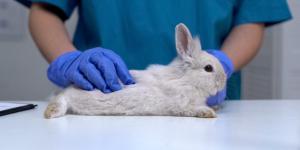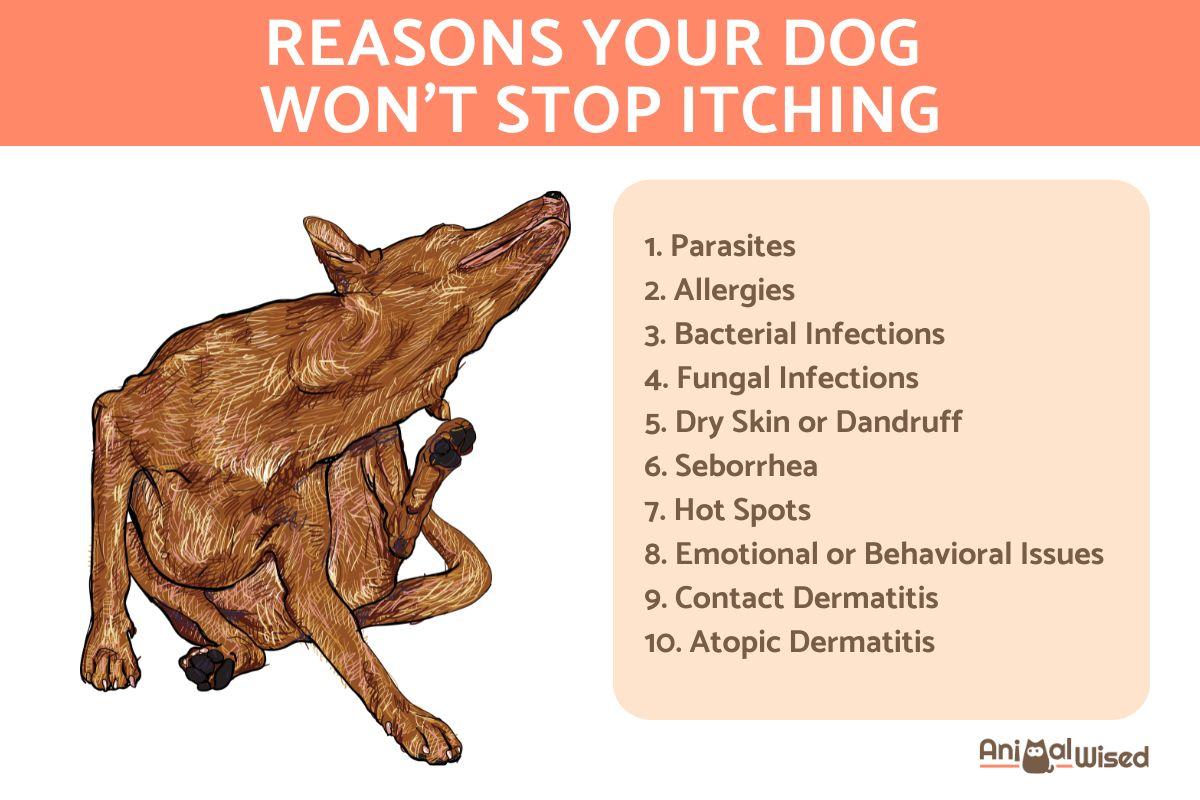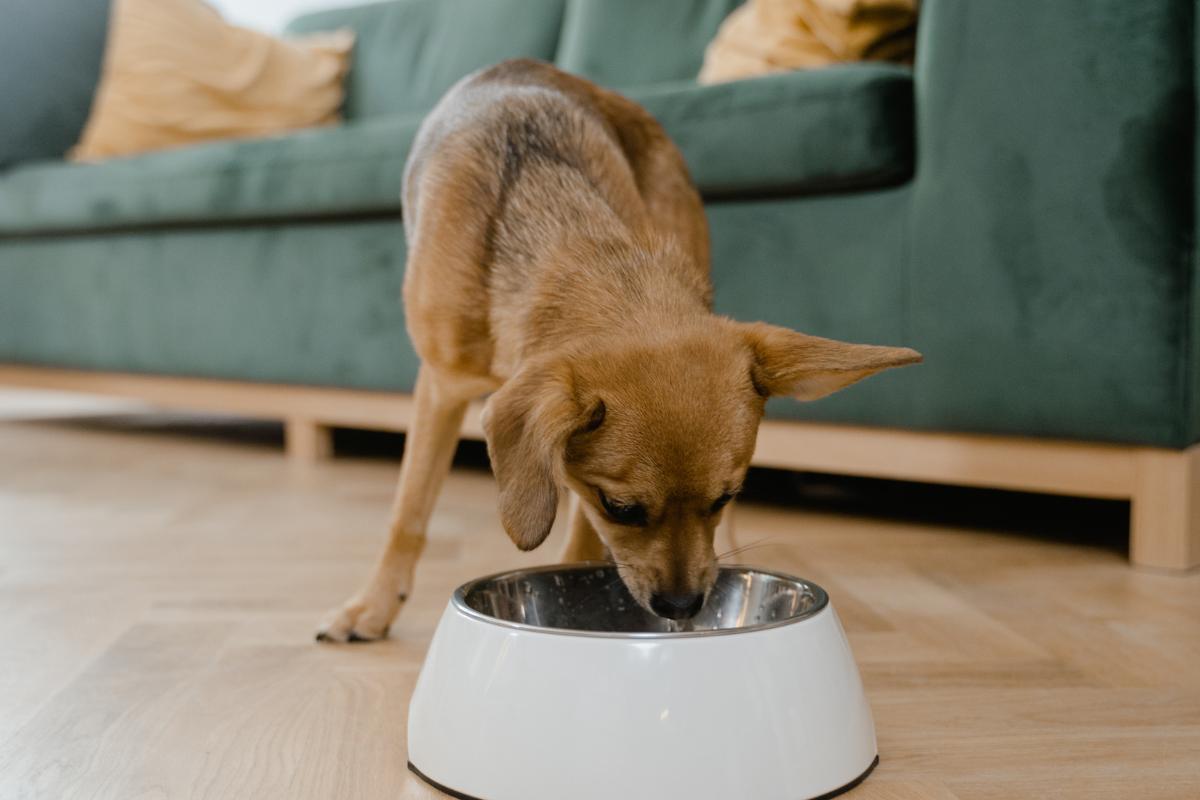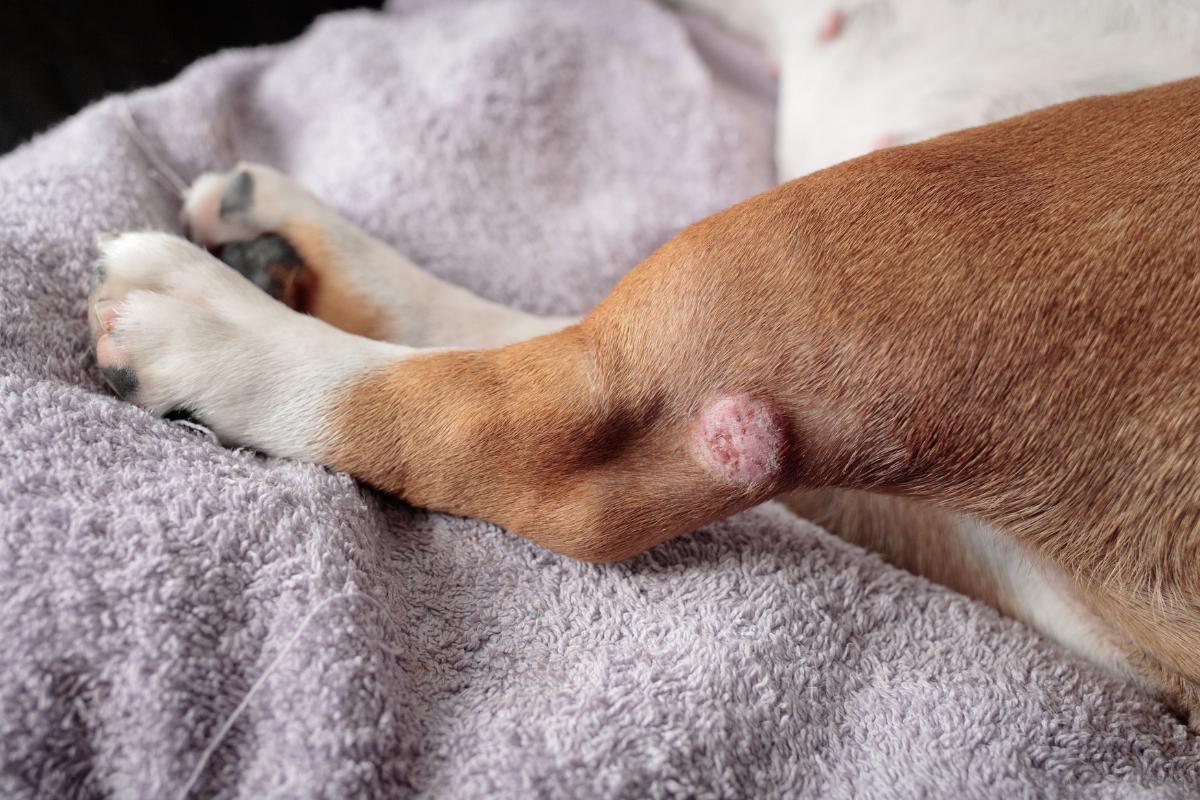My Dog Won't Stop Scratching Themselves



See files for Dogs
Is your dog constantly scratching, biting, and chewing at their fur? Itching is a symptom of an underlying issue, and understanding the cause is key to bringing relief to your pet. Dogs don't scratch themselves for no reason. It's a natural reaction to irritation or discomfort. When a dog is constantly scratching, it suggests the underlying cause is significant enough to cause them persistent distress.
In the following AnimalWised article, we will explore the 10 most common reasons your dog won't stop scratching themselves and what to do about it.
Food allergies
Food allergies in dogs occur when the immune system reacts disproportionately to a food or ingredient that is typically harmless.
This reaction is due to hypersensitivity, which can sometimes be genetic or develop spontaneously even if the dog has previously consumed the food without issues.
Common allergens in dogs include:
- Proteins (chicken, beef, lamb, fish, eggs)
- Cereals (wheat, rice, corn)
- Soy
- Dairy products
When a dog develops an allergy, its immune system treats these substances as threats, leading to a range of symptoms.
It's important to distinguish between food allergies and food intolerances. A food allergy involves an immune response to a specific food that the dog has been exposed to previously. In contrast, food intolerance is a non-immune reaction that can occur without previous exposure to the food.
Symptoms of food allergies in dogs primarily manifest as skin issues. Intense, non-seasonal itching is common, leading to excessive scratching. This scratching can cause peeling, alopecia (hair loss), and increased susceptibility to fungal infections and other types of dermatitis.
What to do:
Diagnosing a food allergy in dogs can be a slow and costly process. Identifying the specific allergen often requires an elimination diet, where potential allergens are systematically removed from the dog's diet to pinpoint the cause of the reaction.
Once the problematic food is identified, it must be completely eliminated from the dog's diet. In some cases, the dog may need to follow a hypoallergenic diet prescribed by a veterinarian for life. If the allergen is successfully removed, the dog should no longer experience symptoms.
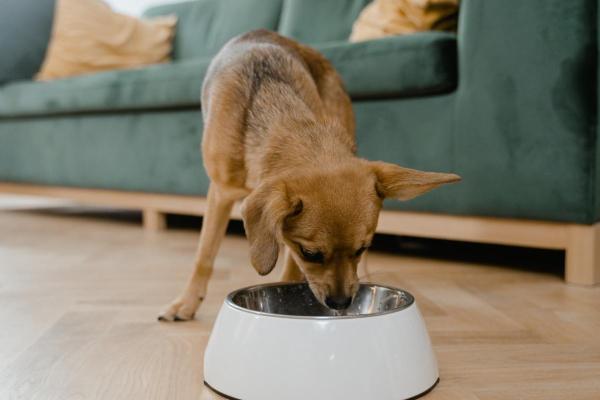
Atopic dermatitis
Atopic dermatitis is a chronic condition in dogs that is closely related to environmental allergies. If your dog won't stop scratching and biting himself, atopic dermatitis could be the reason.
This condition occurs when a dog experiences hypersensitivity to certain environmental elements such as pollen, aerosols, chemicals, or parasites. These allergens cause skin irritation, inflammation, and intense itching.
If the cause of dermatitis is seasonal, such as pollen from certain plants, you might notice that your dog only shows symptoms during specific times of the year, usually in spring. In such cases, you can take preventive measures to avoid the onset of dermatitis. However, identifying the exact cause is not always straightforward, as multiple factors often contribute to the problem simultaneously.
The most characteristic symptoms of atopic dermatitis include not only scratching but also obsessive licking and redness in specific areas of the body. Commonly affected areas are the ear pinna, the axillary region (underarms), and the periocular regions (around the eyes), which often experience hair loss.
What to do:
Managing atopic dermatitis in dogs involves a chronic treatment regimen. This typically includes frequent baths with a specific medicated shampoo to soothe and protect the skin. In some cases, anti-inflammatory and antifungal medications are necessary to control inflammation and prevent infections. Additionally, food supplements that improve skin health can be beneficial in preventing skin infections.
Learn more about dietary management for atopic dermatitis in our other article.

Contact dermatitis
Contact dermatitis is a condition that causes inflammation of the skin in dogs. It is characterized by the appearance of small bumps, redness, dryness, and significant itching. This type of dermatitis typically affects areas with mucous membranes and regions with little hair, such as the armpits, inguinal area, and ear pinnae.
Unlike other types of dermatitis, contact dermatitis is not chronic. It occurs when a dog comes into direct contact with an irritating substance. Common irritants include:
- Chemicals: detergents, soaps, and other household cleaners.
- Plants: certain plants can cause irritation, especially those with stinging hairs.
- Animals: contact with animals that have stinging hairs, such as the pine processionary caterpillar (Thaumetopoea pityocampa).
What to do:
If the contact with the irritant is not severe, moving the dog away from the source and thoroughly cleaning the affected area with plenty of water is usually sufficient. However, if the contact has been prolonged or the reaction is intense, it's crucial to seek veterinary care. The veterinarian can examine the injury and prescribe appropriate treatment.
To prevent contact dermatitis, be vigilant during walks, especially in the spring and summer when plants and insects are more active. Avoid areas where dangerous plants or animals, like the pine processionary caterpillar, have been sighted.
Seborrheic dermatitis
Seborrhea is a skin condition in dogs that results from a problem in keratinization, which is the process of forming and renewing the outermost layer of the skin. When seborrhea is accompanied by skin inflammation, it is referred to as seborrheic dermatitis.
Seborrhea in dogs can manifest in two different forms:
- Dry seborrhea: this type is characterized by frequent, whitish flaking that falls easily to the ground, often referred to as "dandruff."
- Greasy Seborrhea: this form features yellowish scales that adhere to the dog's skin and hair, giving it an oily appearance and causing a bad odor. Greasy seborrhea can lead to complications such as otitis (ear infections) and folliculitis (inflammation of the hair follicles) if left untreated.
Seborrheic dermatitis can appear spontaneously without a known cause, which is termed primary dermatitis. However, it is more commonly linked to underlying conditions, known as secondary dermatitis. Common underlying conditions include scabies, atopic or allergic dermatitis and hypothyroidism.
What to do:
Treating seborrhea involves addressing the underlying cause if it is secondary dermatitis. The treatment regimen typically includes:
- Using medicated shampoos designed to restore the skin barrier and reduce flaking and oiliness.
- Regular baths help maintain skin health and manage symptoms.
- If complications arise, such as infections, the veterinarian may prescribe corticosteroids to reduce inflammation and antibiotics to treat bacterial infections.
Explore the different types of dog dermatitis and their treatments in our follow-up article.

Hot spots
Hot spots, also known as acute moist dermatitis, are a common skin condition that appears quickly and often suddenly in dogs, especially those with thick coats.
This type of dermatitis manifests as a red, sticky, and purulent lesion, often producing a foul-smelling exudate that keeps the area moist. It is commonly found on the face, neck, and other parts of the body where moisture and bacteria can accumulate.
Hot spots can be triggered by several factors, such as parasites, allergies and even existing wounds that become infected. However, the most common cause is keeping the dog's skin moist for extended periods, especially in dogs with thick fur. This often occurs in summer when dogs frequently bathe in lakes, pools, or similar bodies of water.
Even if a dog's coat appears dry on the surface, the inner layers, particularly those in contact with the skin, can remain damp for a long time. This prolonged moisture creates an ideal environment for bacteria to thrive, leading to skin infections and hot spots.
To prevent hot spots, it's essential to ensure your dog's coat is thoroughly dried after bathing. Use towels and, if necessary, a blow-dryer on a cool setting to ensure the fur is completely dry. Finally, regularly brush and groom your dog to prevent matting and allow better air circulation through the coat.
What to do:
The treatment typically involves:
- Shaving or clipping the hair around the affected area to allow better access for cleaning and treatment.
- Washing the lesion thoroughly with a bactericide to eliminate infection.
- Depending on the severity, antibiotics or anti-inflammatories may be prescribed by a veterinarian.
- Use an Elizabethan collar or other methods to prevent the dog from licking or scratching the area, which can exacerbate the condition.

Parasites
As the weather warms up, fleas and mites, along with ticks, start to thrive in areas with abundant vegetation such as parks, fields, orchards, and gardens, posing a significant threat to pets. These tiny parasites are often difficult to see with the naked eye but can cause immense discomfort for animals, leading to constant itching and scratching.
Unfortunately, itching is just one of the problems these tiny pests can cause. Fleas, mites, and ticks can be very dangerous for dogs, acting as vectors for numerous diseases, causing anemia, triggering allergic reactions, and potentially leading to parasitic infections like nematodes (commonly known as "worms") if ingested.
Furthermore, parasites like ticks can transmit serious diseases such as Lyme disease, while fleas can spread tapeworms and cause severe allergic reactions. Not to mention that heavy infestations of fleas can lead to significant blood loss, causing anemia, especially in small or young dogs.
What to do:
If your dog is scratching a lot, the first step is to carefully check its fur for parasites. Focus on areas like the ears, between the toes, and the armpit and groin regions. Fleas are often visible running through the hair and are capable of making significant leaps, so watch closely.
Ticks, on the other hand, are usually attached to the skin and must be removed very carefully using the proper tools. Other parasites, such as mites that cause scabies, are invisible to the naked eye but can cause noticeable lesions characterized by hair loss and redness in specific areas of the body.
The best approach in this case is prevention. Antiparasitic products come in various forms, including collars, topical treatments (pipettes), and oral medications. These products are designed to repel or kill parasites before they can cause harm.
If you suspect your dog has a parasitic infection or you’re unsure about the right products to use, consult your veterinarian. They can examine your pet, provide appropriate treatment, and offer advice on the best preventative measures.
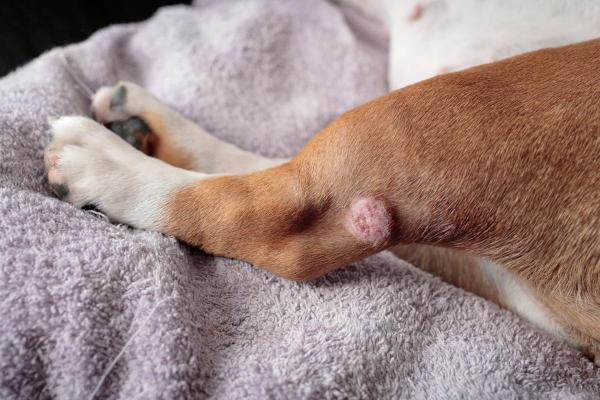
Fungal infection
A fungal infection is a type of infection caused by fungi, which are microorganisms that can invade various parts of the body and cause illness. Fungi are a diverse group of organisms that can include yeasts, molds, and dermatophytes.
Fungi and yeast can cause dermatitis and otitis in dogs, resulting in intense itching and discomfort. These infections are often opportunistic, targeting animals with pre-existing skin vulnerabilities such as other dermatological issues or bacterial infections, which can complicate treatment.
Dermatitis from fungi presents with localized hair loss, skin peeling, and hardened darkened areas. Otitis caused by fungi typically includes symptoms like brown discharge with a strong odor.
What to do:
Treating these conditions can be lengthy due to fungal resistance, requiring strict adherence to veterinary-prescribed treatments to ensure complete elimination.
Fungal infections may also be contagious, emphasizing the importance of following treatment protocols, especially in households with children or other pets.
Explore bacterial & fungal infections in our follow-up article for a more comprehensive diagnosis.
Stress
It's important to recognize that not all symptoms in dogs stem from physical illness or pathology. If a dog scratches frequently and medical conditions have been ruled out, it's crucial to consider the possibility of an emotional issue.
Persistent stress and anxiety can trigger erratic or obsessive behaviors in dogs as they try to alleviate discomfort. Factors such as insufficient environmental stimulation, prolonged periods of solitude, inadequate socialization, fears, past traumas, or restrictions on natural behaviors can elevate stress levels in dogs. This stress may manifest as stereotypical or self-harming behaviors.
What to do:
Understanding our pets' emotions can be challenging, but as responsible guardians, it's our duty to identify the underlying causes of their behaviors and provide appropriate support.
Consulting a professional ethologist can offer valuable insights and guidance if you notice any behavioral changes in your dog. Explore 10 signs of doggy distress in our other article.
This article is purely informative. AnimalWised does not have the authority to prescribe any veterinary treatment or create a diagnosis. We invite you to take your pet to the veterinarian if they are suffering from any condition or pain.
If you want to read similar articles to My Dog Won't Stop Scratching Themselves, we recommend you visit our Other health problems category.
- Brazís, P., Queralt, M., Fondati, A., De, C., & Veterinaria, D. (nd). Available at: https://saludanimal.leti.com/es/alergia-e-intolerancia-alimentaria-en-el-perro-y-el-gato_1206.pdf

